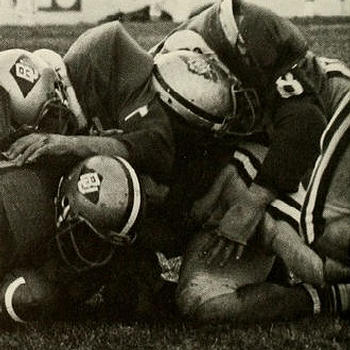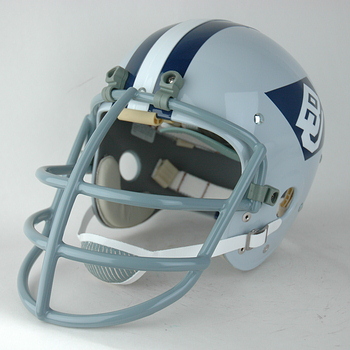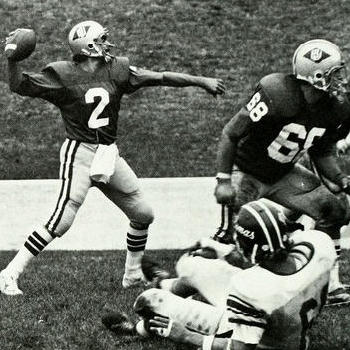

Butler University
1977
Bulldogs
(Authentic Reproduction)
Every conference has fans who claim that their favorite is “the best,” “the toughest,” or “the most talented.” Of course the strength of each major or lower level football conference varies year to year or decade to decade. The quality of coaching and recruiting, recent offensive and defensive trends, and many other factors put some ahead of others. The academic and social milieu of any specific university however, will be more stable, with general trends or standings that are established and then reinforced. We can hope that schools are always seeking to upgrade and improve their physical plants, faculty, and course offerings but statistical analysis will generally reveal which colleges are “better” than others.
|
|
|
In the Midwest, Indianapolis’ Butler University is one of the lesser known gems of the football community, a “small college” playing at the Football Championship Subdivision (FCS or what used to be designated as D 1AA) level. Always strongly based academically, the stable enrollment of approximately 4000 students has enjoyed the benefits of sound faculty and congenial environment of what is one of the higher ranked private universities in the various “Best Of…” polls. As the first coed college in the state of Indiana, it has perhaps become best known athletically as a “basketball school” with its ascension to the Big East Conference in that sport. Butler however, had known football excellence for decades playing on the smaller stage of “Little College Football” and through its growth into D 1AA. The Butler Bulldogs made the jump to D 1AA from the College Division in 1973, in the midst of one of its most successful gridiron championship runs.
As a member of the Indiana Collegiate Conference (ICC), Butler captured fourteen conference football titles in the 1950’s and ‘60’s under legendary coach Paul “Tony” Hinkle. Deservedly credited as the man who put Butler athletics, and especially basketball, into the national consciousness, Hinkle served as a teacher and administrator for over seventy years, as well as the head mentor for basketball, baseball, and football at Butler from 1921 through 1970. The orange basketball was one of his many innovations and he developed the Hinkle System of basketball offense that left his record as one of the most sterling in NCAA history. His basketball resume was such that many historians have forgotten that he was also a terrific and successful football coach.
 |
 |
One of Hinkle’s former Bulldogs quarterbacks, Bill Sylvester, who had spent time as a high school coach, Purdue assistant, and then a Butler assistant from 1964 through ’69, was named head coach in 1970. He held the head coaching reins through ’84 before focusing on his position as athletic director. He kept much of the Hinkle magic, winning conference championships from 1972 through ’75, and again in both 1977 and ’83. The mid-1970’s squad was feared for the offensive prowess they possessed, with future Depauw, Ball State, and Indiana University head coach Bill Lynch as the quarterback and team leader. Lynch, a two-year captain, completed his career at Butler in ’76 having amassed 5909 passing yards and sixty TD tosses. A three-time Conference MVP and conference record holder in all passing categories, Lynch set the standard at Butler while attracting an exceptionally high level of talent to the program, many anxious to be a part of what was obviously going to be a winning succession of teams. Butler Athletic Hall Of Fame member Dave Swihart, a four-time All Conference choice and two-time Lineman Of The Year at tight end was an obvious standout, and running backs Mark Morelli, Bob Bartolomeo, Kevin McDevitt, Bruce Scifries, Harry Muta, and Mark Bohnert set a slew of rushing records, with one topping the other in what appeared to be an endless line of top rated fullbacks and halfbacks.
 |
 |
Of course, these highly rated backs who set numerous school and conference records ran behind consistently effective offensive linemen. Craig Paulsen, Bruce Ford, and Ken LaRose were among the better known and award winning big men in the trenches but typical of the lesser lauded ones were Joe Chaulk. The former Greater Cincinnati League award winner from Roger Bacon High School fulfilled a regular role as a scrappy, four year letter winner at offensive guard for the Bulldogs and he was rewarded with All Conference recognition in 1977.
Butler had worn a Navy blue helmet with white flanking stripes for a number of years, until the 1975 season. They switched to a light gray shell with a one-inch white center stripe and Navy blue flanking stripes, although a number of players did not have the flanking stripes applied until late in the season. A new interlocking white “BU” placed within the boundaries of a Navy blue background completed a very modern and clean appearance. These same helmets were worn through the remainder of Joe Chaulk’s Butler career in ’77 and continue to serve as a reminder of the very successful transition from the “Hinkle Era” to the “Sylvester Era” of Butler football.